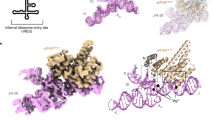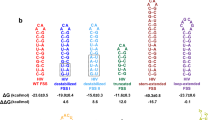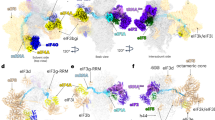Abstract
Eukaryotic protein synthesis begins with mRNA positioning in the ribosomal decoding channel in a process typically controlled by translation-initiation factors. Some viruses use an internal ribosome entry site (IRES) in their mRNA to harness ribosomes independently of initiation factors. We show here that a ribosome conformational change that is induced upon hepatitis C viral IRES binding is necessary but not sufficient for correct mRNA positioning. Using directed hydroxyl radical probing to monitor the assembly of IRES-containing translation-initiation complexes, we have defined a crucial step in which mRNA is stabilized upon initiator tRNA binding. Unexpectedly, however, this stabilization occurs independently of the AUG codon, underscoring the importance of initiation factor–mediated interactions that influence the configuration of the decoding channel. These results reveal how an IRES RNA supplants some, but not all, of the functions normally carried out by protein factors during initiation of protein synthesis.
This is a preview of subscription content, access via your institution
Access options
Subscribe to this journal
Receive 12 print issues and online access
$189.00 per year
only $15.75 per issue
Buy this article
- Purchase on Springer Link
- Instant access to full article PDF
Prices may be subject to local taxes which are calculated during checkout






Similar content being viewed by others
References
Pestova, T.V., Lorsch, J.R. & Hellen, C.U.T. The mechanism of translation initiation in eukaryotes. in Translational Control in Biology and Medicine (eds. Mathews, M.B., Sonenberg, N. & Hershey, J.W.B.) 87–128 (Cold Spring Harbor Laboratory Press, Cold Spring Harbor, NY, 2007).
Fraser, C.S. & Doudna, J.A. Quantitative studies of ribosome conformational dynamics. Q. Rev. Biophys. 40, 163–189 (2007).
Doudna, J.A. & Sarnow, P. Translation initiation by viral internal ribosome entry sites. in Translational Control in Biology and Medicine (eds. Mathews, M.B., Sonenberg, N. & Hershey, J.W.B.) 129–153 (Cold Spring Harbor Laboratory Press, Cold Spring Harbor, NY, 2007).
Elroy-Stein, O. & Merrick, W.C. translation initiation via cellular internal ribosome entry sites. in Translational Control in Biology and Medicine (eds. Mathews, M.B., Sonenberg, N. & Hershey, J.W.B.) 155–172 (Cold Spring Harbor Laboratory Press, Cold Spring Harbor, NY, 2007).
Pisarev, A.V., Shirokikh, N.E. & Hellen, C.U. Translation initiation by factor-independent binding of eukaryotic ribosomes to internal ribosomal entry sites. C. R. Biol. 328, 589–605 (2005).
Fraser, C.S. & Doudna, J.A. Structural and mechanistic insights into hepatitis C viral translation initiation. Nat. Rev. Microbiol. 5, 29–38 (2007).
Pestova, T.V., Shatsky, I.N., Fletcher, S.P., Jackson, R.J. & Hellen, C.U. A prokaryotic-like mode of cytoplasmic eukaryotic ribosome binding to the initiation codon during internal translation initiation of hepatitis C and classical swine fever virus RNAs. Genes Dev. 12, 67–83 (1998).
Trachsel, H., Erni, B., Schreier, M.H. & Staehelin, T. Initiation of mammalian protein synthesis. II. The assembly of the initiation complex with purified initiation factors. J. Mol. Biol. 116, 755–767 (1977).
Benne, R. & Hershey, J.W. The mechanism of action of protein synthesis initiation factors from rabbit reticulocytes. J. Biol. Chem. 253, 3078–3087 (1978).
Ji, H., Fraser, C.S., Yu, Y., Leary, J. & Doudna, J.A. Coordinated assembly of human translation initiation complexes by the hepatitis C virus internal ribosome entry site RNA. Proc. Natl. Acad. Sci. USA 101, 16990–16995 (2004).
Spahn, C.M. et al. Structure of the 80S ribosome from Saccharomyces cerevisiae–tRNA-ribosome and subunit-subunit interactions. Cell 107, 373–386 (2001).
Taylor, D.J., Frank, J. & Kinzy, T.G. Structure and function of the eukaryotic ribosome and elongation fractors. in Translational Control in Biology and Medicine (eds. Mathews, M.B., Sonenberg, N. & Hershey, J.W.B.) pp. 59–85 (Cold Spring Harbor Laboratory Press, Cold Spring Harbor, NY, 2007).
Spahn, C.M. et al. Hepatitis C virus IRES RNA-induced changes in the conformation of the 40S ribosomal subunit. Science 291, 1959–1962 (2001).
Passmore, L.A. et al. The eukaryotic translation initiation factors eIF1 and eIF1A induce an open conformation of the 40S ribosome. Mol. Cell 26, 41–50 (2007).
Kolupaeva, V.G., Pestova, T.V. & Hellen, C.U. An enzymatic footprinting analysis of the interaction of 40S ribosomal subunits with the internal ribosomal entry site of hepatitis C virus. J. Virol. 74, 6242–6250 (2000).
Otto, G.A. & Puglisi, J.D. The pathway of HCV IRES-mediated translation initiation. Cell 119, 369–380 (2004).
Spahn, C.M. et al. Cryo-EM visualization of a viral internal ribosome entry site bound to human ribosomes: the IRES functions as an RNA-based translation factor. Cell 118, 465–475 (2004).
Unbehaun, A., Borukhov, S.I., Hellen, C.U. & Pestova, T.V. Release of initiation factors from 48S complexes during ribosomal subunit joining and the link between establishment of codon-anticodon base-pairing and hydrolysis of eIF2-bound GTP. Genes Dev. 18, 3078–3093 (2004).
Fraser, C.S., Berry, K.E., Hershey, J.W. & Doudna, J.A. eIF3j is located in the decoding center of the human 40S ribosomal subunit. Mol. Cell 26, 811–819 (2007).
Pisarev, A.V., Hellen, C.U. & Pestova, T.V. Recycling of eukaryotic posttermination ribosomal complexes. Cell 131, 286–299 (2007).
Hartz, D., McPheeters, D.S., Traut, R. & Gold, L. Extension inhibition analysis of translation initiation complexes. Methods Enzymol. 164, 419–425 (1988).
Anthony, D.D. & Merrick, W.C. Analysis of 40 S and 80 S complexes with mRNA as measured by sucrose density gradients and primer extension inhibition. J. Biol. Chem. 267, 1554–1562 (1992).
Kozak, M. Primer extension analysis of eukaryotic ribosome-mRNA complexes. Nucleic Acids Res. 26, 4853–4859 (1998).
Kieft, J.S., Zhou, K., Jubin, R. & Doudna, J.A. Mechanism of ribosome recruitment by hepatitis C IRES RNA. RNA 7, 194–206 (2001).
ElAntak, L., Tzakos, A.G., Locker, N. & Lukavsky, P.J. Structure of eIF3b RNA recognition motif and its interaction with eIF3j: structural insights into the recruitment of eIF3b to the 40 S ribosomal subunit. J. Biol. Chem. 282, 8165–8174 (2007).
Joseph, S. & Noller, H.F. Directed hydroxyl radical probing using iron(II) tethered to RNA. Methods Enzymol. 318, 175–190 (2000).
Reynolds, J.E. et al. Unique features of internal initiation of hepatitis C virus RNA translation. EMBO J. 14, 6010–6020 (1995).
Jivotovskaya, A.V., Valasek, L., Hinnebusch, A.G. & Nielsen, K.H. Eukaryotic translation initiation factor 3 (eIF3) and eIF2 can promote mRNA binding to 40S subunits independently of eIF4G in yeast. Mol. Cell. Biol. 26, 1355–1372 (2006).
Pisarev, A.V., Kolupaeva, V.G., Yusupov, M.M., Hellen, C.U. & Pestova, T.V. Ribosomal position and contacts of mRNA in eukaryotic translation initiation complexes. EMBO J. 27, 1609–1621 (2008).
Pestova, T.V. & Kolupaeva, V.G. The roles of individual eukaryotic translation initiation factors in ribosomal scanning and initiation codon selection. Genes Dev. 16, 2906–2922 (2002).
Fraser, C.S. et al. The j-subunit of human translation initiation factor eIF3 is required for the stable binding of eIF3 and its subcomplexes to 40 S ribosomal subunits in vitro. J. Biol. Chem. 279, 8946–8956 (2004).
Pestova, T.V. & Hellen, C.U. Preparation and activity of synthetic unmodified mammalian tRNAi(Met) in initiation of translation in vitro. RNA 7, 1496–1505 (2001).
Spanggord, R.J., Siu, F., Ke, A. & Doudna, J.A. RNA-mediated interaction between the peptide-binding and GTPase domains of the signal recognition particle. Nat. Struct. Mol. Biol. 12, 1116–1122 (2005).
Kieft, J.S. et al. The hepatitis C virus internal ribosome entry site adopts an ion-dependent tertiary fold. J. Mol. Biol. 292, 513–529 (1999).
Lomakin, I.B., Kolupaeva, V.G., Marintchev, A., Wagner, G. & Pestova, T.V. Position of eukaryotic initiation factor eIF1 on the 40S ribosomal subunit determined by directed hydroxyl radical probing. Genes Dev. 17, 2786–2797 (2003).
Culver, G.M. & Noller, H.F. Directed hydroxyl radical probing of RNA from iron(II) tethered to proteins in ribonucleoprotein complexes. Methods Enzymol. 318, 461–475 (2000).
Pisarev, A.V., Unbehaun, A., Hellen, C.U. & Pestova, T.V. Assembly and analysis of eukaryotic translation initiation complexes. Methods Enzymol. 430, 147–177 (2007).
Acknowledgements
We thank D. King at the University of California, Berkeley, for expert MS analysis of modified proteins. We gratefully acknowledge members of the Doudna laboratory for discussions and comments on the manuscript. In particular, we would like to thank R. Spanggord for advice on hydroxyl radical probing and F. Siu for advice on RNA transcription protocols. This work was supported in part by a grant from the US National Institutes of Health to J.A.D. and J.W.B.H.
Author information
Authors and Affiliations
Contributions
C.S.F. performed the experiments; C.S.F., J.W.B.H. and J.A.D. designed experiments and wrote the manuscript.
Corresponding author
Supplementary information
Supplementary Text and Figures
Supplementary Figures 1 and 2 (PDF 1034 kb)
Rights and permissions
About this article
Cite this article
Fraser, C., Hershey, J. & Doudna, J. The pathway of hepatitis C virus mRNA recruitment to the human ribosome. Nat Struct Mol Biol 16, 397–404 (2009). https://doi.org/10.1038/nsmb.1572
Received:
Accepted:
Published:
Issue Date:
DOI: https://doi.org/10.1038/nsmb.1572
This article is cited by
-
HCV IRES manipulates the ribosome to promote the switch from translation initiation to elongation
Nature Structural & Molecular Biology (2013)
-
Structure of the full-length HCV IRES in solution
Nature Communications (2013)
-
Design of gold nanoparticle and DNA oligomer conjugates for enhancement or suppression of in vitro gene expression
BioChip Journal (2013)
-
Visualization of codon-dependent conformational rearrangements during translation termination
Nature Structural & Molecular Biology (2010)



